ISSN 2410-5708 / e-ISSN 2313-7215
Year 10 | No. 29 | October 2021- January 2022
© Copyright (2021). National Autonomous University of Nicaragua, Managua.
This document is under a Creative Commons
Attribution-NonCommercial-NoDerivs 4.0 International licence.
Emotional intelligence in situations of work stress: UNAN-Managua Procurement Division
https://doi.org/10.5377/rtu.v10i29.12733
Submitted on December 14, 2020 / Accepted on August 18, 2021
M.A. Francisco Martínez Báez
Musician, Culturologist and Art Historian
National Autonomous University of Nicaragua, Managua
Section: Humanities and Arts
Scientific Article
Keywords: Emotional intelligence, work stress, healthy college, mental health, moods
Abstract
The objective of this research work is to analyze through a survey the moderating function of emotional intelligence in situations of work stress in the Procurement Division of UNAN-Managua, in which there were some interesting findings during the process, for example, that workers pay attention to their feelings, emotions, moods among them. With this we intend to lay the foundations for further research that could determine the mental health of university staff, especially in a complicated national context, thereby establishing a relevant intervention plan that contributes to a collective harmonious environment, in order to establish stress management strategies and allow them to improve mental health.
1. Introduction
The basis of any action is our thoughts, an effect of a mental process, a thought generates – ostensibly – feelings. Thoughts relate to external events, over which we do not have much control, our thoughts belong to us, they are ours. Therefore, we might rightly believe that we can decide for ourselves which thoughts to have, that will generate the right feelings and responses at the right time. In a situation that requires optimism, have thoughts oriented towards possibility and confidence. In work relationships there will undoubtedly be diversity of thoughts of feelings, each person has their own values and personality. Disagreements are natural and so are the points of view, but, when it comes to a common goal, it is to work for the mission and vision of the university .
This research work seeks to lay the foundations for other interdisciplinary work, from the perspectives of objective studies on the mental health of workers, both administrative and teaching, even students. Although it is not easy to take the train of thought and change its route. Our brain is, after all, a complex machine “Neurosciences study the organization and functioning of the nervous system and how the different elements of the brain interact and rise to the behavior of human beings” (Manes & Niro, 2015, p. 25)
Of course, you cannot analyze the full range of essential concepts related to the sciences, such as psychology or sociology, but you may want to understand and become familiar with the concept of emotional intelligence, its individual characteristics and its role in the modern work environment. Who does not have personal problems? The answer is, everyone... the secret is how to handle it. In general, when we talk about the ability to manage one’s own emotions, we refer to skills such as consciousness, maintaining control over one’s own actions and emotions, as well as the manifestation of empathy in interpersonal relationships. All this can be seen both in times of stress in the office and in private life. Stress at work is a common reality in many departments and colleges of the university, a worker motivated by a word of encouragement by the immediate boss is usually more efficient.
“What can we do if we are trapped by a ‘kidnapper’? The first thing is to realize what is happening. Kidnappings can last seconds, minutes, hours, days or weeks. To some, if they have become accustomed to living in a bad mood or in fear, it may seem like their “normal” state (Goleman, 2013, p. 57).
Fundamentally, anxiety has an important role for survival, preparing the body for the necessary fight-or-flight reactions in case of danger. In addition, in moderate doses, it helps to identify possible problems in the future and, consequently, to react in the direction of preventing their appearance. It is scientifically proven that a certain level of anxiety increases performance capacity, but too high a level of anxiety inhibits this ability, acting as an obstacle. “Wenger studied with children and adults (...) and obtained significant differences in the autonomic balance depending on situational conditions inducing anxiety and the presence or absence of psychosomatic disorders” (Casado, 1994, p. 54)
Therefore, anxiety is not negative in itself, but anxiety disorders have the need to seek specialized help. Distress and anxiety disorders can be mediated with the management of emotions through self-awareness. Emotional intelligence as a mean of defense will undoubtedly be useful in a seemingly hostile environment. A worker is able to lucidly evaluate his emotions, who will know how to better handle peak moments of pressure, in which the challenges are duplicated by the tensions felt on a personal level. As they move forward in the hierarchy, there are often tensions between those responsible and subordinates.
“The Universidad Nacional Autónoma of Nicaragua, Managua (UNAN-Managua), the largest public university in Nicaragua” (Mendieta, 2016, p. 30),whose headquarters are scattered in four regional multidisciplinary faculties in the interior of the country, in the departments of Carazo, Estelí, Matagalpa and Chontales, also has the university program in the rural areas, in it, there is a great diversity of careers, and many different teaching departments and administrative instances. Therefore, interpersonal working relationships between fellow teachers, students and administrative workers can become complex. University authorities or team leaders, in particular, need to establish a level of general emotions that streamlines work processes. This requirement excludes both the excessive expression of emotions and the total absence of their manifestation. Regardless of the field in which you work or the position you hold, a valuable employee for the university in which you work, will double your academic background through an exemplary balance.
Daniel Goleman said that between men and women they are so empathetic interpersonally, some women, on the other hand, seem to cope with stress as well as the more flexible than men (Goleman, 1998). It should be noted that, in fortuitous situations, when the order was not delivered on time, or that, the user urgently needs what was requested, or that there were some type of delays etc, when the pressure is greater, it is when you begin to lose your nerves, that is when stress comes into action, “then, it has negative effects on health when it is intense and prolonged. That is, when it exceeds the individual resources of the person to face it” (Arias, 2012, p. 526 )
For this reason, mental health in labor relations is vital, because they allow to develop an effective collective collaboration in the daily work, to be more productive in the area where the worker develops, because the attitude is paramount, especially those offices that, due to their dynamism and constant work under pressure. “Who defines a healthy work environment as one in which workers and managers collaborate in using a process of continuous improvement to protect and promote the health, safety and well-being of workers” (Castañeda, Betancourt, Salazar, & Mora, 2017, p. 2)
A leadership model should be an indispensable quality in leaders with responsibilities within the university, such as “participatory leadership, promoter and coordinator of actions that favor work climates where the participation process is dynamize” (Garbanzo & Orozco, 2010, p. 22),from the Superior Management to deans, directors of departments or area coordinators. “From the perspective of the psychology of well-being, which understands it as a determining component of people’s mental health, an axial model for the evaluation of general well-being is described” (Arocena, Mejía, & Gondra, 2006, p. 87).
It should be noted that it is not intended to propose a recipe for interpersonal relationships, especially in the work environment, but to analyze how we can manage stress. Generally in a complicated situation there is usually a certain tendency to irritability when frustration reaches a peak. On the other hand, “one of the dimensions that contribute to human beings having a quality of life, and even more so in the workplace, a good state of health allows the adequate development of work activity” (Herrera, Betancur, & Jiménez, 2017, p. 6). Emotions are reactions that can remain deeply ingrained in our consciousness. The idea that your partner or immediate boss has rebuked the subordinate because an involuntary mistake was made, emotions such as anger and pain will be generated. However, emotions do not always generate thoughts. You may have emotions that are not conscious or that cannot be explained. “Emotions are a substantial part of human life. We continually experience emotions. But we rarely stop to reflect on what emotions are, how they influence thinking and behavior” (Alzina, 2009, p. 15).
The “problem” situation should be considered as an opportunity to improve, unfortunately, sometimes work difficulties are personalized and create unnecessary conflicts, especially when the ego individualism to excel over others prevail over the sense of collectivity. All disagreements are overcome as long as there is awareness that the points of view are going to be different. Leading a work group, either by department or by faculties, there are common goals to direct the aims, objectives, mission and vision of the university.
The recognition, phrases or words that motivate the worker will have a positive impact on their attitude. “The advantages that teamwork systems bring at the organizational level are not enough; but they analyze benefits that they bring to the members of the teams such as the satisfaction of the recognition needs” (Castaño, 2007, p. 369)
It is argued that the closest approximation of emotional intelligence is the processing capacity of cognitive and emotional information (perception, organization and integration of emotions) and the subsequent measurement of these capacities that through the Emotional Intelligence Test of Mayer, Salovey and Caruso can help a better study of the important function that these skills have in work contexts.
Despite recent interest in the study of emotional intelligence and its effects on people’s behavior. In fact, emotional intelligence should not be confused with mental health, with respect to the concept itself, its implementation and application in the work environment. In any case, the levels of Emotional Intelligence are intrinsically related to good mental health, but, if low levels of Emotional Intelligence persist in the individual, then there will be certain psychological disorders. In fact, Emotional Intelligence has a moderating role on medical symptoms and diseases. (Martínez González, Piqueras, & Ramos Linares, 2010)Poor mental health affects behavior, mood, and thinking in a way that hinders the normal course of activities of daily living.
A mentally ill person who no longer accepts itself or others has an excessive concern for its own body and its own person, when it loses touch with reality when retiring to its own world and can no longer adapt to social, occupational and cultural norms “Mental health is a priority issue within the field of public health this is confirmed by the different epidemiological studies that account for the contribution of mental disorders to the global burden of disease” (Restrepo & Jaramillo, 2012, p. 203)
Trait theory highlights conscious, general, and social aspects of emotional intelligence. The emotional capacity approach sees information processing capabilities as part of a set.
We do not intend to go further, but to lay the theoretical foundations for a field research in the Rubén Darío University campus as a delimited place or space, we are aware that the UNAN Managua is the largest University in Nicaragua, but the research will take as a sample the Division of Acquisitions and Imports; recommendations will be made for the entire University.
We know that no person is an island, we are all connected in one way or another, therefore, the national context usually affects. No one is invulnerable, political, economic, social problems, the cost of living, the outstanding bills payable etc. They are powerful influencers on human behavior, that is, on mental health. Having a resilient attitude could be possible, as long as there is a firm will to know how to face an adverse situation with nobility. In these needs it is the only emotional intelligence that can respond to vehement events. By integrating intelligence with emotion, at least some correct feelings can be determined to distinguish individuals based on emotional intelligence in a given cultural context. The Argentine neuroscientist Facundo Manes, said that, “today we know the way we think determines the way we feel (...) you create reality, and you can change the way you think to change the way you feel, and that’s a good way to deal with stress or reality, which sometimes you cannot change. What we can change is how we revalue reality” (BBVA, 2020)
Today, in addition to increased competition, organizations also face exponential technological development and innovation, and change processes that affect the emotional states of all employees. All these challenges, together with the required changes and the complexity of organizational and management tasks, imply new emotional demands and more effective actions at the institutional level, including through the management of emotions in most circumstances. So, emotions are valuable resources for innovation and added value in an economic process. Emotional intelligence has been an important and controversial topic in recent decades. Emotional intelligence is the key to feeling, thinking, learning, solving problems and making decisions. Any university worker can be upset, especially if their boss has not been able to manage their own emotions and offloads it on the subaltern. But being angry with the right person, to the right degree, at the right time, with the right purpose, and in the right way, is not easy.
For this purpose, emotional intelligence is the ability to process emotional and cognitive information (perception, organization and integration of emotion) and the consequent measurement of those skills. It is assumed that emotions are complex, as Laprida warns when he says: “Although emotions are a complex construct to define, there is some agreement regarding their most basic characteristics. Emotions are composed of multiple facets and factors, such as physiological, cognitive, social and behavioral”(Laprida, 2013, p. 2).
The above indicates that when dealing with emotions there is usually a physiological reaction, there may also be a response in our behavior since all thought action affects our moods, the willingness to establish healthy relationships in the work environment and react to certain external events, whether they are adverse or favorable. When a person is going through a difficult situation, family work or personal, their reactions may be erratic and distracted, at a time they will know what is happening in their head.
There have been studies that have shown that our bodies undergo significant changes in hormonal physiology, it is stress that causes our immune system to fall, and is exposed to hypertensive diseases, heart disease and even diabetes, these “clinical and experimental studies in humans have shown that psychosocial stress produces an increase in the susceptibility and evolution of infectious diseases, and an increase in the time of wound healing in young and adult individuals” (Gómez, 2006, p. 30)
Frequent and normal interpersonal relationships, we react to certain situations lived every day, the same, usually trigger social stimuli and, a cognitive dimension since they are interpreted individually, or from personal experience, in general, not always what is perceived coincides with reality. As Velasco Bernal points out, regulating our emotions is important for well-being and personal growth: “in fact, ‘perception, understanding and emotional regulation are of vital importance for adaptation to our environment and contribute substantially to psychological well-being and personal growth’ (Velasco Bernal, p. 1 2014)
2. Theoretical Framework
When psychologists started writing and thinking about intelligence, they focused on cognitive aspects like memory and problem solving. However, there were researchers who recognized early on that non-cognitive aspects were equally important. According to David Wechsler (1943) intelligence is one’s general ability to act intentionally, reasonably, and interact effectively with the environment. From that moment, according to Martín, there was a need to agree on a joint definition: “On the theoretical level, successive attempts to agree on a definition of intelligence revealed its value as a capacity to adapt to the environment”(Martín, 2012, p. 50).
In 1940, Wechsler referred to non-mental and mental elements with which he referred to emotional, personal and social factors. Furthermore, in 1943, Wechsler suggested that non-mental abilities are essential for predicting one’s ability to succeed in life. The same, “... describes the influence of non-intellective factors on intelligent behavior, and further argues that our intelligence models will not be complete until they can adequately describe these factors” (Marcos, 2017, p. 6).
Wechsler wasn’t the only researcher to discover that the non-intellectual aspects of intelligence are important to a person’s adaptation and success. Robert Thorndike, for example, wrote about social intelligence in the late thirties. Unfortunately, the work of these pioneers was largely forgotten or ignored until 1983, when Howard Gardner began writing about multiple intelligences. Gardner (1983) suggested that intrapersonal and interpersonal intelligence is as important as the type of intelligence generally measured by IQ and related tests.
According to Dueñas Buey, it is from the second half of the nineteenth century that interest in the subject of intelligence is resumed, which meant some advances: “In the second half of the nineteenth century the interest in deepening the knowledge of the area of intelligence is confirmed, producing since then certain advances that were making possible the subsequent developments”(Dueñas Buey, 2002, p. 77).
Returning to the historical look at industrial and organizational psychology, in the 1940s the Ohio State Study Center suggested that careful treatment of workers is important for better outcomes. Specifically, research suggests that leaders who are able to generate feelings of mutual trust, respect, and some warmth with their team members are more effective. There are two classic assumptions about intelligence. “The first considers that it is a unique general capacity, which any person possesses to a greater or lesser extent. The second states that it can be measured through standardized instruments”(Trujillo, 2005, p. 2). Around the same time, the Office of Strategic Services (1948) developed an evaluation process based on Murray’s earlier work (1938) that included the assessment of non-cognitive and cognitive abilities. Many of the parameters measured in assessment centres since then include social and emotional skills such as communication, sensitivity, initiative and interpersonal skills.
Other aspects of research and theory can be mentioned, but it is clear that since the early 1990s there has been a long tradition of research on the role of non-cognitive factors, and how these can help people succeed both in their lives and in their workplace. On these foundations is based the current research on emotional intelligence. When Mayer and Salovey coined the term emotional intelligence in 1990, they were aware of previous research on non-cognitive aspects of intelligence. They described emotional intelligence as “a form of social intelligence that involves the ability to monitor one’s own and others’ emotions and feelings, discriminate between them, and use information to guide one’s own thinking and actions or behaviors.”(Salovey & Mayer, 1990)
Salovey and Mayer also launched a research program designed to develop valid measurements and outcomes for emotional intelligence and to explore its importance. For example, in one study they looked at a group of people watching a movie that could cause discomfort and negative emotions those who scored highest on an emotional clarity test (which is the ability to recognize and name the mood we were experiencing) and those who regained their temper faster. In another study, people who scored higher on the ability to accurately perceive, understand, and appreciate the emotions of others were able to respond more flexibly to changes in their social environment and the creation of supportive social networks.
Another researcher on emotional intelligence and its characteristics, Reuven Bar On1, proposed a model based on personality theory that highlights the ability of personality traits to co-depend on their application to personal well-being. It examines five components of emotional intelligence which are: intrapersonal, interpersonal, adaptability, stress management, and general disposition with the individual components of each subcategory. Bar on estimates that emotional and cognitive intelligence contributes to a person’s overall intelligence that shows they have the potential to succeed in life. The Bar-On model provides the theoretical basis for the EQ-i2, which was originally developed to evaluate various aspects of this model as well as its conception. According to this model, emotional-social intelligence is a representative sample of interrelated emotional and social competencies, skills, and mediators that determine how effectively we can understand and express ourselves, others, our relationship with them, and our daily requirements.
In the early 1990s, Daniel Goleman focused on the work of Salovey and Mayer, and this led to the writing of his book, “Emotional Intelligence.” Goleman was the author of scholarly articles for the New York Times, where his specialty was brain and behavioral research. He had received training as a psychologist at Harvard University, where he worked with David McClelland3, among many others. McClelland (1973) was in a growing group of researchers investigating how small traditional tests of cognitive intelligence tell us about what it takes to succeed in life.
For McClelland, all motivation is based on emotion and consists, specifically, in an expectation of change in the affective condition. One reason is then the re-establishment, by an indication, of a change in an affective situation. In this definition, reset means that prior learning is involved. In McClelland’s system, all social motives are learned. McClelland takes affection as the basis for motives for several reasons: on the one hand, because emotional states of pain and pleasure can be manipulated experimentally when working with motivations, and on the other, because affection provides more explanatory elements than other theories based on the reduction of biological needs or intense stimulation(Winter, 2000, p. 531).
Meanwhile, Goleman speaks of “heart intelligence” and defines emotional intelligence as “one’s ability to recognize one’s own emotions and the emotions of others, manage them effectively, and motivate oneself.” In the introduction to his book on Emotional Intelligence, Goleman refers to the following quote from Aristotle to define the essence of Emotional Intelligence: (Goleman, Emotional Intelligence, 1995)
In Aristotle’s Work of Nicoma Ethics, he said that being angry is easy. But getting angry at the right person, for the right reason, to the right degree, at the right time, with the right purpose, and in the right way, is difficult. A diverse destiny which has in the soul of man sensation, intelligence and instinct; the free preference of the soul, illustrated by reason, is always the beginning of movement. (Goleman, Emotional Intelligence, 1995)
It is also necessary to know four emotional skills: 1) self-awareness: it refers to the awareness of emotions, self-esteem and self-confidence. 2) Self-management: refers to self-discipline, self-regulation, reliability, awareness and adaptability. 3) Social awareness: are skills of influence, communication, leadership, catalytic action in change, conflict management, bond building, collaboration, teamwork. 4) Relationship management: the ability to understand others, encourage the development of others, the correct management of diversity.
The concept of Emotional Intelligence in a more understandable and practical way proposed by Goleman; refers to the “emotional dimension of logic”, therefore, Emotional Intelligence is the ability of a person to recognize and realize their emotions and use that awareness to manipulate their behavior and relationships. Stresses that emotional intelligence determines how: a) we behave b) we manage the complexity of our social relationships c) we make personal decisions that lead to positive outcomes, in which, Goleman proposes four emotional skills similar to those that constitute the concept of Emotional Intelligence in practice: Self-management which means using our awareness of emotions to be flexible and direct our behavior in the desired direction; social awareness that refers to the ability to perceive what others think and feel, even if we don’t feel the same; relationship management that refers to the ability to successfully manage and, in the long run, our interactions with other people.
Emotional intelligence
Many researchers view emotions in a negative way as a disorganized disruption of the intellectual exercise that is presented rationally. For many years, this view has been inherent in the management literature, which has traditionally emphasized business logic and advocated for the need for leaders to manage emotions outside the organization or at least degrade them in a way that does not cause anything bad.
For example, he described emotions as without a trace of conscious purpose and therefore defined them as severe disturbances for the individual as a whole. In contrast, other researchers such as have argued that emotions are necessary in logical thinking because they are related to values also saw emotions as a positive thing about organizational responsiveness, which focuses on adapting to cognitive activities and with a later impact. (Young, 1930)(Damasio, 1994)
According to Goleman, academic intelligence does not predict ultimate success in our lives. Throughout this article we want to analyze Goleman’s proposal and bring a different perspective to EI’s study of school performance. Although it has been proven that a high verbal and mathematical intelligence in a student is a good predictor of their academic performance, is the same with emotional skills? Can high intrapersonal emotional intelligence benefit academic performance? In such a case, what can be its mechanism of action? Are emotional and academic intelligence really independent? Do they have bonds? (Pacheco, Extremera, 2001, p. 2)
Other authors focus (Leeper, 1948) their attention on the driving force of emotions and that emotions trigger processes that stimulate, maintain and direct attention. Meanwhile Lazarus indicates that:
To study emotion within this frame of reference is to suggest that emotion expresses a relationship between perception and action. It implies, therefore, that motivation and emotion occur when the organism tries to extend its control to the limits of what it is perceiving(Lazarus et al., 1969, p. 117).
The idea that individuals differ in their mental capacity and in how they process emotional information to use it effectively has been a key concept in the study and development of social intelligence. The idea of social intelligence is based on Thorndike and his study of the emotions of individuals. "In 1920 Thorndike considered intelligence to refer to a person's ability to understand and manage other people and to engage in adaptive social interactions"(López, 2007, p. 18). From the results of his research, he concluded that people differ in their ability to understand other people and perceive human relationships differently. He sees this diversity in the form of intelligence as the ability to understand and manage people" and can also be seen as the ability to understand and manage ourselves. However, for many years no research results have been found to support the impression that social intelligence can be easily separated from other types of intelligence.
In the early 1980s, interest in the concept of social intelligence arose again. It was based on studies of the effects on the human brain; (Gardner, 1983) he proposed a method with many types of intelligence, which included two separate elements that are described as “interpersonal” and “intrapersonal” intelligence. The term “interpersonal intelligence” describes the ability to understand and discern the feelings and motivations of others. On the other hand, “interpersonal” refers to the ability to understand one’s own feelings and motivations. Quoted by Jaqueline Suárez (2004, p. 217), he says that...
The theory proposed by Gardner is an interesting and creative way to achieve such a purpose; it raises the existence of eight or more intelligences namely: Logical-mathematical intelligence, Linguistic intelligence, Spatial intelligence, musical intelligence, body-kinesthetic intelligence, intrapersonal intelligence, interpersonal intelligence and naturalistic intelligence. (Suárez, 2010, p. 84)
Around the same time, Sternberg (1985) proposed a theory of three forms of intelligence and divided it into analytical and practical intelligence. On the one hand, analysis is very close to general intelligence and the academic concept of problem solving. Practical intelligence represents real-world intelligence, including relationship skills.
In problem solving, the immediate goal is specific, and the logical and orderly modes of approach to it are the most appropriate, if not the ones always used. In the creative process there is no such specific goal as a rule, and illogical modes of thought are very frequent. (...) consider that creative activity seems to be simply a special kind of problem-solving characterized by originality, by its unconventionality, by its persistence and difficulty in formulating the question. An important differentiation between the two is the degree of involvement of the whole person in each case: in the creative process this involvement is very large and the non-cognitive and emotional elements have ample weight, while in problem solving these factors are more a barrier to effectiveness than an aid (Sternberg & O’Hara, 2005, p. 125).
The notion of Emotional Intelligence
The notion of emotional intelligence has become popular among organizations and offers the market research and education many perspectives of study to understand the emotional nature of people. According to the American Society for Training and Development, four out of five companies are actively trying to increase the emotional intelligence of their employees to increase sales, improve customer service, and ensure that their management is sound.
Several issues have been raised, such as the financial value of choosing the personal basis of emotional intelligence. For example, he argued that insurers with a high emotional intelligence index achieved sales that were more than double those of smaller ones. Following the same line, they affirm that the concept of emotional intelligence (EI) has been extremely relevant to various authors” and showed that employees with high emotional intelligence achieved twice as many goals as employees with low and medium emotional intelligence. (Goleman, Emotional Intelligence, 1995)(García Izquierdo, García Izquierdo, & Ramos Villagrosa, 2007)
Another explanation for how EI mediates coping with stress is that emotionally intelligent individuals have more constructive thought patterns. These people would be able to observe more precisely or accurately their own thoughts and the impact they have on their emotions (Landa, 2011, p. 8).
The link between emotional intelligence and performance gain has begun to appear in organizations primarily in the service sector. In the mid-1990s in the United States, the book “The Bell Curve” (Herrnstein & Murray, 1994) was published, a book on race, intelligence and social mobility that touched on the principles of liberalism where the authors were subsequently accused of racism and elitism to use flawed data to support modern policies. The best academics and researchers of the time concluded that The Bell Curve is an example of racist science. Authors such as Joseph L. Graves have conducted studies on intelligence and its relationship to many different factors such as work or income.
The publication of Goleman’s book, Emotional Intelligence (1995), presented a positive view in a piece of the bell curve, which argues that success in life is based more on how people manage their emotions and the feelings of others, no matter how bright they are in intellect. This assessment of competence, which many describe as irrational and lacking serious evidence reinforced the already accepted notion that being courteous, warm and friendly is an important path to success at a time when emotions in the workplace were beginning to gain traction.
Goleman’s central argument is summarized in that emotional intelligence is one of the main success factors in life with potentially greater impact than cognitive intelligence on many aspects of human behavior, including work and education. It should be noted that while Salovey and Mayer had introduced the term into the scientific literature in 1990 it was the publication of Goleman’s first book, which marked the beginning of research of interest to the subject of many branches of psychology. That argument was repeated especially to researchers who criticized traditional intelligence research as short-sighted and limited.
However, the growing interest in the study of the emotional aspects of psychology and applications in recent years, combined with limited scientific research has created conceptual and other problems. Some scholars, who (Davies, Stankov, & Roberts, 1998)argued that emotional intelligence cannot be the subject of scientific psychology and should remain in the realm of psychology for the general public. For the purposes of the article, the proposal of Salovey and Mayer on the competences of emotional intelligence and the subsequent measurement of the test of individual differences will be taken into account since they are a reliable and valid method of the object.
The recent interest in emotional intelligence (EI) is the result of twenty years of research in the area of social psychology of offerings with cognitive processes and emotions. During this time, many researchers have examined individual differences in understanding, experience, and expression of emotions. Other researchers found that a person’s emotional state is highly incidence in procedures such as memory.
The following questions: What is sadness? What is anger? What is fear? Are they just words or is there something else? In principle, sadness, anger, fear are emotions; “As Hans Selye established, some stress is essential and healthy; the optimal amount of stress is ideal, but too much stress is harmful” (Camargo, 2004, p. 79). Generally, it is usually considered that emotional states correspond in personal experience that are then expressed through the body, gestures, in language, in the way they see us or how we look at others, sometimes six of being considered as irrational and subjective. For example, when we are angry about some unpleasant situation, from that inner perspective we reflect or externalize our discomfort.
In 1990, they argued that there is a different type of intelligence(Salovey & Mayer, 1990) than cognitive intelligence that can be reliably measured.
However, both are complementary, and, in fact, the rise of this concept has been due in large part to the fact that knowledge and emotions are interrelated, and explain the different levels of success in various areas of life. Thus, for most authors, knowledge or cognitive intelligence cannot be considered as the only predictor of success(Fuentes Pérez, 2014, p. 109).
Emotional intelligence Salovey and Mayer originally defined as the perception, expression, and regulation of emotions. This initial approach was relatively inactive for several years until the publication of Goleman’s book (1995) on emotional intelligence caused great interest to the general public and was followed by a second volume on emotional intelligence.
Goleman’s approach had variants to the initial definition of EI such as the perception, expression, and regulation of emotions (Salovey and Mayer, 1990). For example, Goleman’s definition includes aspects of emotional empathy, intelligence, motivation, and social skills. It is necessary to distinguish emotional intelligence competencies from other general aspects of personality related to emotional intelligence skills. This distinction is necessary both in the scientific and practical level.
On a scientific level recently, the ambiguity of the term has led some authors to question the validity of the concept of emotional intelligence. The conceptual clarification of the same term in this article is not only of theoretical interest. It is necessary to have a clear instance of knowledge to be able to apply the concept of EI in particular contexts (education, work, etc.) . Another important reason for the conceptual clarification of the term is the application of tools to measure EI in practice.
Emotional Intelligence: Ability or General Personality Trait?
In the literature there are two approaches to emotional intelligence that differ mainly in two points: a) if it follows the more general social-emotional definition of EI or narrower definition such as cognitive, emotional and b) the tools used to measure individual differences in heart disease and its applications.
The general socio-affective model of emotional intelligence by Goleman and other researchers, more recently, emphasizes individual differences in the organization and expression of emotions and related social skills (empathy, adaptability, general emotional state, etc.). “Self-awareness, motivation, self-regulation, empathy and competence in relationships are conceptualized as the conglomeration of practices and aspects of the personality structure that help effective performance and improve people’s personal triumph” (Ríos Bello, 2019, p. 12)
Application of emotional intelligence skills in work contexts.
Emotional intelligence competencies as stated above, are not the only success factor at work. Undoubtedly, cognitive intelligence, along with a number of other variables (socioeconomic context, culture, etc.) play an important role in success and satisfaction in work or education. But the individual skills that make up the scientific definition of emotional intelligence is important in employment/organizational contexts; I will first cite some simple examples and then move on to discuss the results of recent studies. The exact perception of emotions in oneself and others is an important factor for the cultivation of interpersonal relationships. For example, if someone is not able to realize that their/colleague/boss etc, have a positive mood or negative mood can cause the behaviors not to promote good cooperation.
Very important is also the integration of emotion with other cognitive processes and behaviors. For example, people who have creative type occupations. Researchers should know how to manage their emotions to get the best results (for example, to generate new ideas when they have a good mood.
As I mentioned earlier, the general literature on the effects of positive psychological memory functions of mood, judgment, and social behavior tend to agree on the role of positive emotions. In addition, the functional organization of emotion is a very important factor in decision-making and correlated with leadership capacity and personnel management. Finally, the understanding of emotions allows us to understand how individual feelings in conjunction with individual states provide incentives to achieve goals both in work contexts.
Primary functions among which are the planning actions necessary for good university development. To achieve these goals, it is necessary to know how to work as a team, with a sense of empathy, belonging and companionship. To achieve the objectives, it is necessary to be aware of the understanding towards the other or another, that is, that we are all necessary to know and know about emotional intelligence. “Practical intelligence is understood as the ability to solve the practical problems of life for a better adaptation to the context”(Leal, 2011, p. 3).
Emotional intelligence is imperative in social processes, our interpersonal relationships. In fact, emotional and cognitive intelligence is a continuous permanent process whose objective is the process of learning, of unlearning that aspects of our life as a precise complement in individual emotional cognitive development, in which it constitutes the indispensable elements in personal development in an integral way. For this, it is an indispensable condition the development of skills and abilities in the understanding of emotions, that is, knowing how to manage our emotions from an awareness that empathy to face the challenges that arise in daily life, especially in interpersonal relationships. All this is aimed at personal and social well-being.
3. Material and Methods
The National Autonomous University of Nicaragua, UNAN-Managua has a total of 2,721 workers, of which 1,697 are administrative workers and 1,024 are teachers. The above is an indicator of the complexities that can be had in the treatment and interpersonal relationships.
For the purposes of this investigation, the procurement division belonging to the administrative vice-rectory will be taken as a sample; the University’s web portal indicates that the role of the Procurement Division is to ensure all university-wide purchases and services:
The Procurement Division is an administrative body that operates under the authority of the Rector. For organizational reasons it is under the direction of the Administrative and Management Vice-Rectorate. The Procurement Division is responsible for ensuring all functions, tasks and activities for administrative procurement, to meet institutional needs in the field of purchases of goods and services, developed with efficiency, economy, integrity and transparency, as well as strict adherence to the law of the matter and the internal regulations of the University. (UNAN-Managua, 2020)
Knowing that the stress levels in this division are enormous due to the whole process that must be carried out to meet institutional needs, all the people who work in the Contracting and Import Unit will be taken to implement the instruments, so that the findings found in them and they allow to make pertinent recommendations to the entire university. The organizational scheme of this division is:
The method is of a non-experimental type. It is an investigation that is done without deliberately manipulating variables. (Hernandez Sampieri, 2014)
The research design is cross-sectional or cross-sectional as data collection will be done in a single moment. It is descriptive because it investigates the variables in a population. This study considers the personal impressions of the respondents about emotional health both in their private lives and in their work performance within the UNAN-Managua.
The research techniques to be used are:
1.Semi-structured interview: Qualitative technique that is based on a question guide and the interviewer can introduce additional questions depending on the inputs provided by the interviewee.
2.Survey: It consists of a questionnaire of closed questions where several answer options are presented, for the purpose of the research a horizontal format will be used.
The first part of the survey is based on the TMMS-24 that corresponds to the Trait Meta-Mood Scale (TMMS) of the Salovey and Mayer research group. The second part considers important aspects of mental health in the university workplace, of own elaboration. A scale of values is used with the following levels: no agreement, some agreement quite agree, very much agree and totally agree.
A closed survey was conducted on 16 people, of whom 10 are women and 6 are men; all the people surveyed are from the Contracting and Import Unit. The ages of the people surveyed range from 26 to 55 years
For the analysis of the data, the emptying of the information will be carried out in a Microsoft Word sheet and for the processing of the data obtained SPSS for Windows will be used. The inclusion criteria of the people surveyed are two:
•Work in the Procurement area of the National Autonomous University of Nicaragua, UNAN-Managua.
•People who are willing to collaborate with the study.
4. RESULTS
Below, the main findings are presented and then discuss the main findings according to the objectives set out in the study. To this end, the aspects presented in the survey will be broken down.
The first statement of the survey states: I pay close attention to feelings. The graph indicates that some of the respondents do pay attention to their feelings to a greater or lesser degree. Only one person indicated that he does not pay attention to his feelings.
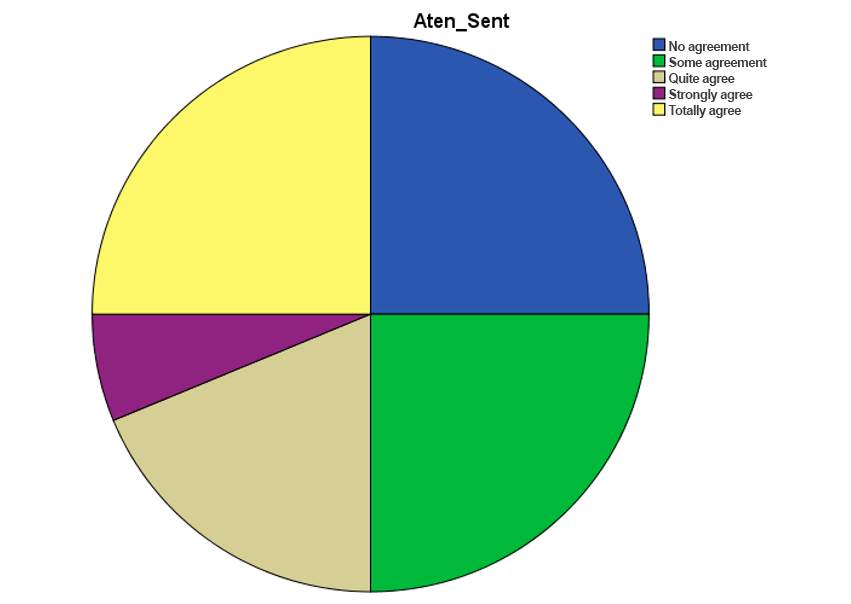
Figure 1.
Atention to the feelings
On statement 4 which is read: “I believe that the penalty is related to my emotions and state of mind, only 19% of the sample fully agreed with that statement.
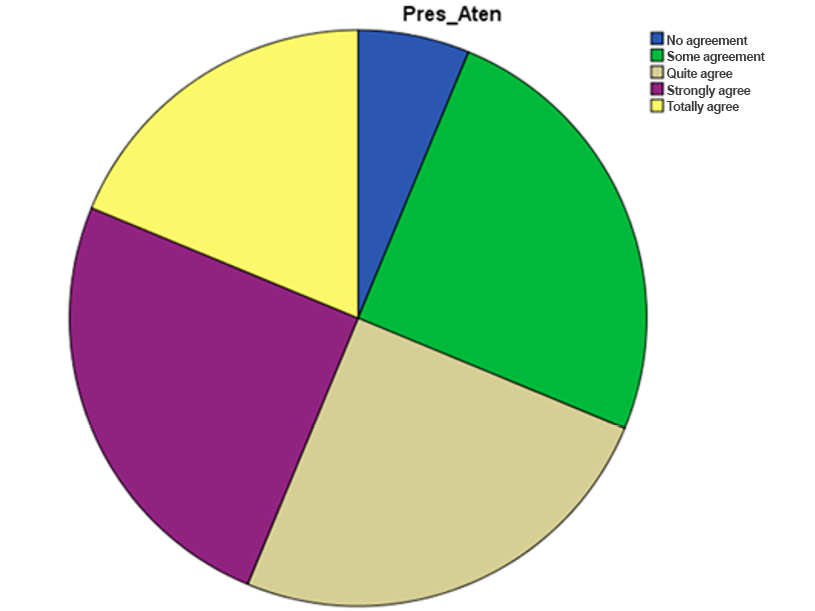
Figure 2.
Pay attention to the emotions
Regarding paragraph 5, the majority of respondents consider that feelings do not affect their thoughts.
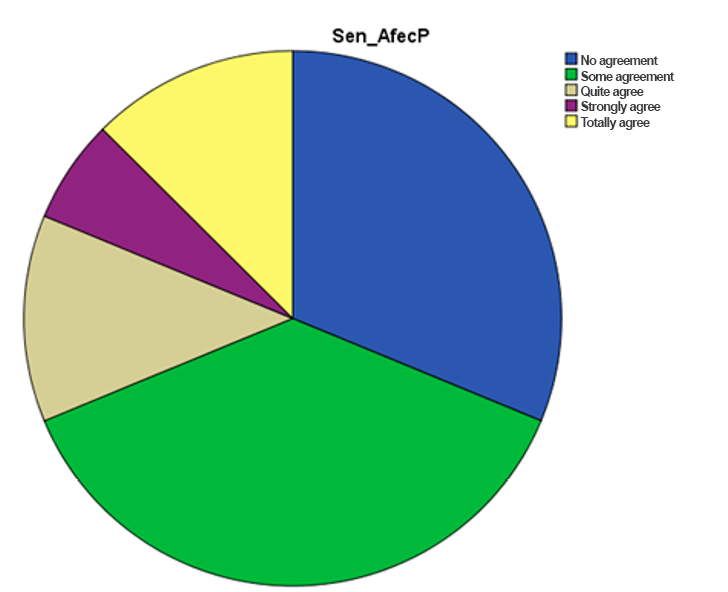
Figure 3.
Feelings affects thoughts
As for mood, most workers indicate that they don’t think about their mood.
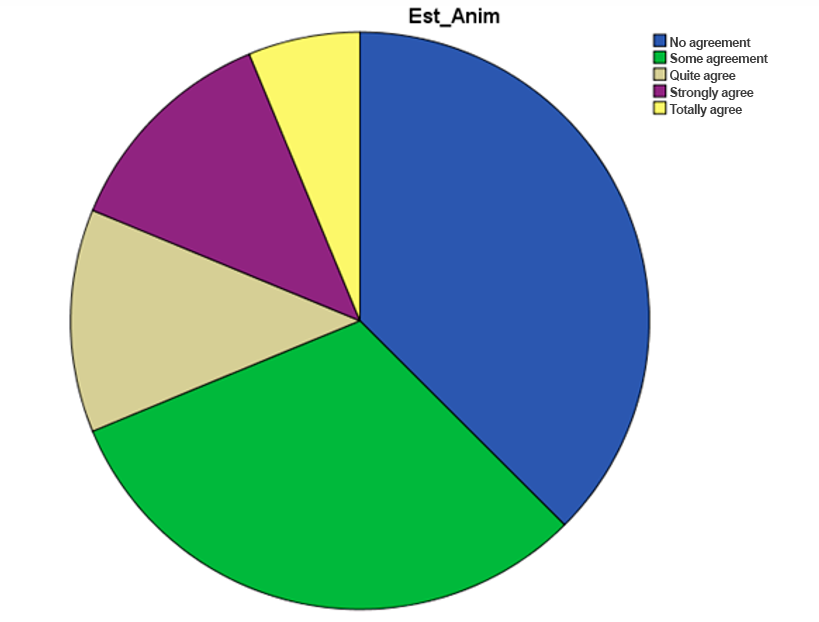
Figure 4.
Mood
As for the statement #8: I pay close attention to how I feel, nine people in the sample indicated that they quite agree with the statement.
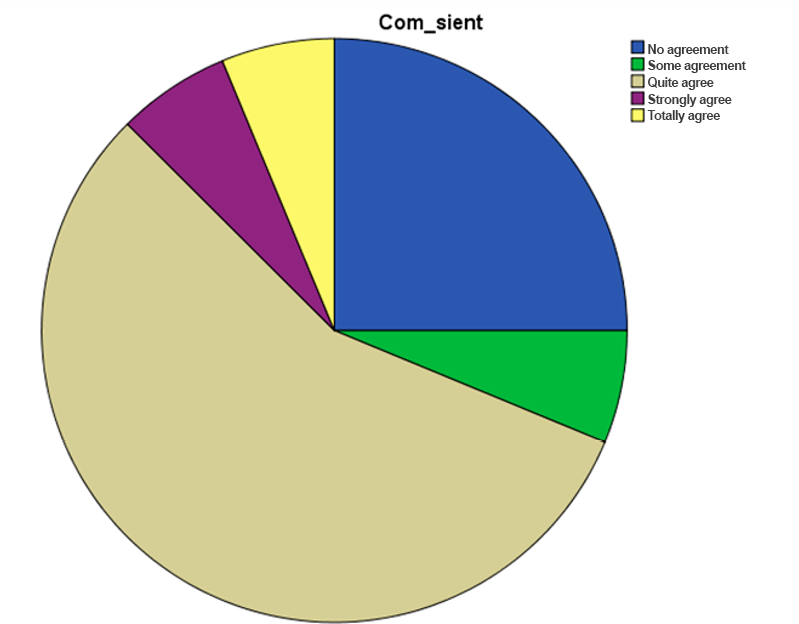
Figure 5.
I pay attention about how do I feel
Statement 1 of the second part of the survey states: When I am stressed about work I take an active break, only three people were totally in agreement with the fact of taking an active break when there is work stress.
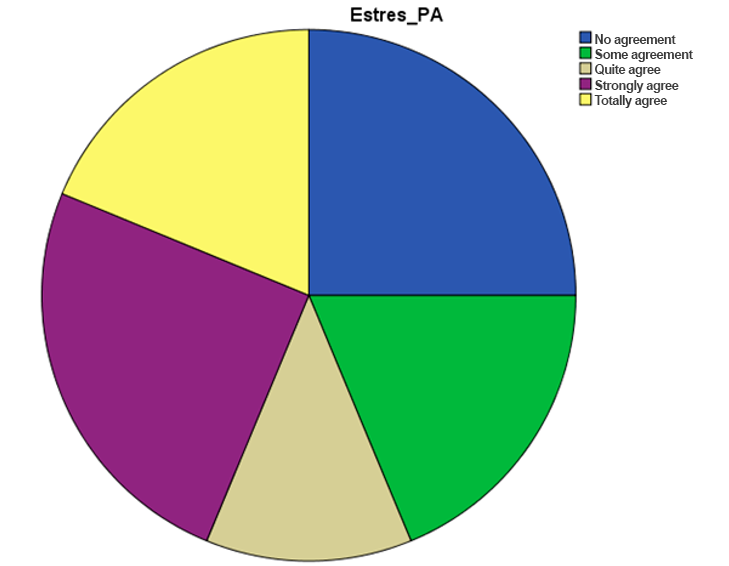
Figure 6.
Relation to stress and active pause
Regarding statement 2 indicating whether the university has activities such as yoga, dancing or others for stress management, a total of 6 people indicated that they do not agree with the statement.
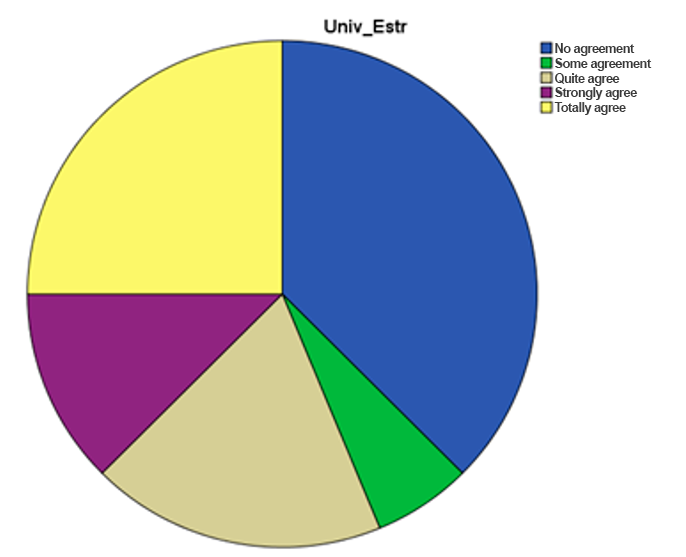
Figure 7.
Universities activities
Statement 4: When I get stressed I tend to argue with my co-workers. It’s interesting that half of the people surveyed agree with the statement.
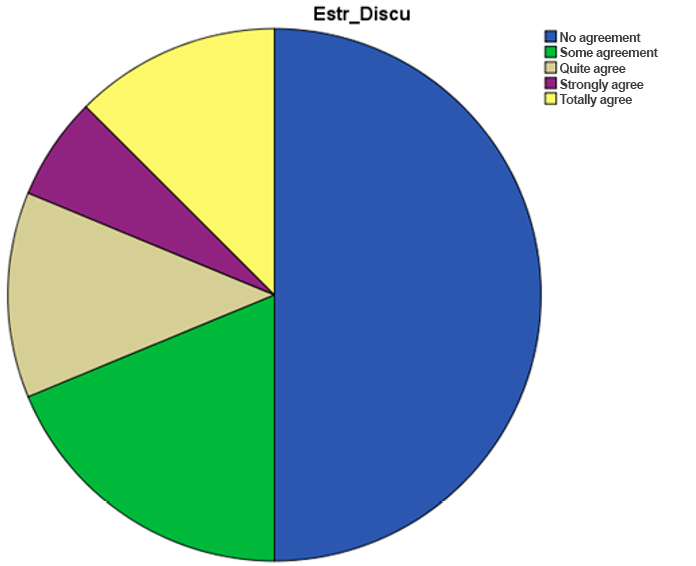
Figure 8.
Relation between stress and discussions
Regarding statement 5 which states: When I get stress at work I perform breathing exercises to stay calm, most people indicated that they do not, to be exact, 7 people indicated that they do not perform any type of breathing exercises.
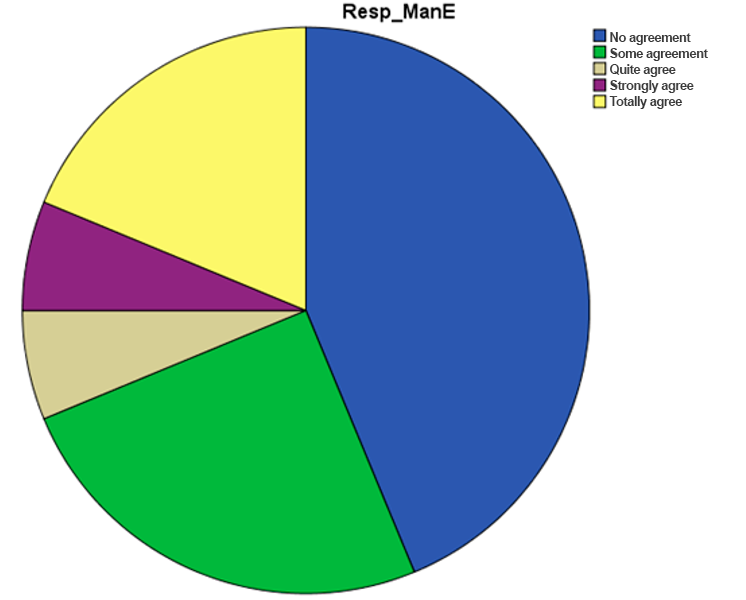
Figure 9.
Breathing exercises to keep the calm
Statement 7 indicates: There is a policy in the University for the management of stress, most of the respondents indicated that there is no university policy for the management of work stress, exactly 9 people of the respondents said that there is no policy aimed at managing work stress.
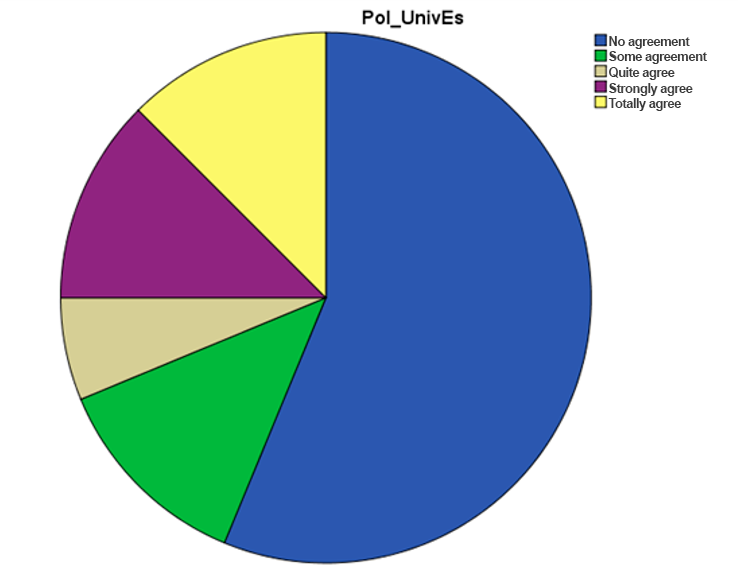
Figure 10.
Existence of universities policies to manage the stress.
Regarding statement 9: You would like to have a university policy for the management of work stress, the majority of respondents indicate that they fully agree with the statement. Nine people are happy with the idea of a university policy for the management of work stress.
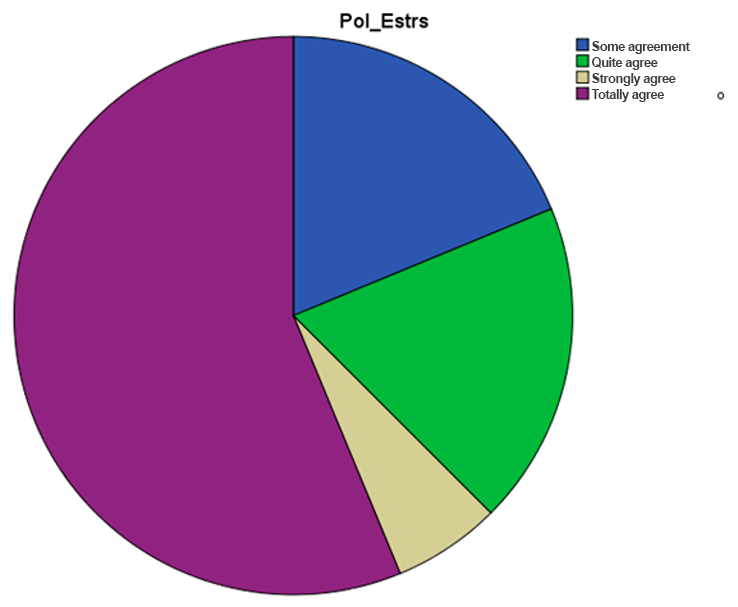
Figure 11.
Interest for a universities policy.
Regarding statement 10: I have a respectful and kind relationship with my co-workers, most indicated that they fully agree with the statement, which shows the importance of respect and kindness in the labor relations of this division.
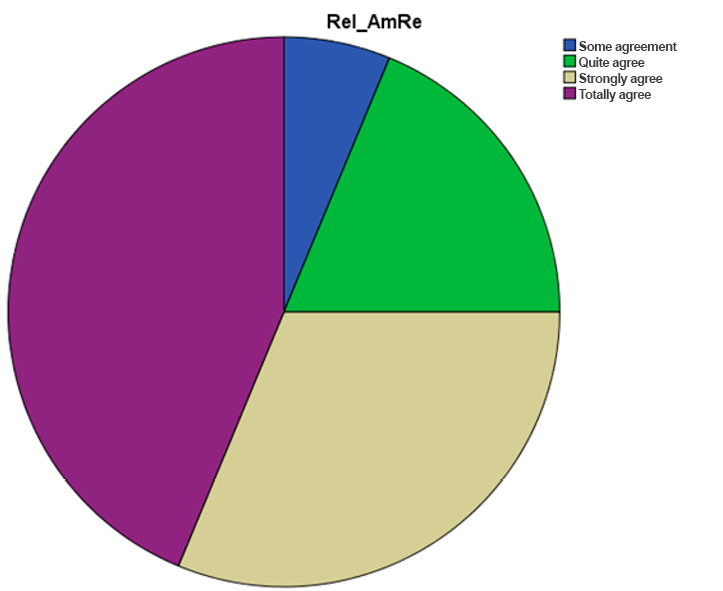
Figure 12.
Interpersonal relations in the labor sphere
Statement 11 states: My coworkers have a personal strategy for stress management, the majority of respondents somewhat agreed with the statement. In the discussion a contrast was made with some previous answers, which indicate that many times stress is not managed properly.
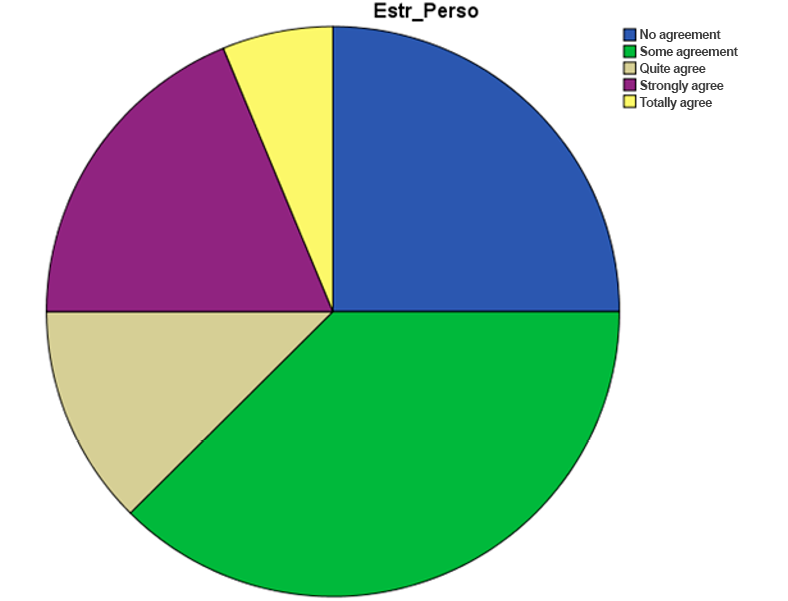
Figure 13.
Personal strategies about emotional intelligence.
In paragraph 12 regarding the following statement: Generally at work we know how to handle work stress, most of them indicated that they do not agree with the statement; that corroborates some data found on the little management that is made of work stress which has an impact on emotional health.
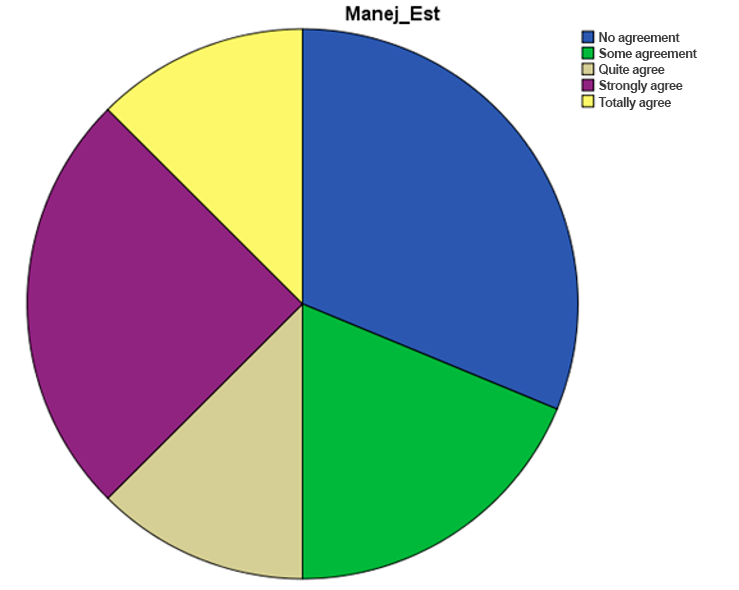
Figure 14.
Management of the labour stress.
An interesting fact is that most of the workers indicated that they like the work they do at the University. This information is based on the last statement presented in the survey questionnaire, which says: Loving my job is a quality that allows me to manage stress. It is very important for stress management, to do what you like, to work in an area in which you are happy.
5. DISCUSSION
The WHO emphasizes that mental health is more than the absence of mental disorders or disabilities. Having optimal mental health not only means avoiding mental illness, but also taking care of your happiness and well-being. It also refers to health itself, “as a state of complete physical, mental and social well-being, and not only the absence of affections or diseases. It therefore recognizes mental health as an essential component of health” (WHO, 2013, p. 48).
Certainly, increased job demands can stress someone out. However, by exercising emotional intelligence that can be applied at work, stress can be reduced. Work performance can also increase. A malfunctioning printer or photocopier, a slow internet connection, or conflicts with bosses and co-workers can trigger stress at work. The administrative procedures that require compliance in a timely manner are the requirements stipulated in accordance with Law 737 and its regulations, and those corresponding to Decree 75-2010. In the management, when the user does not carry the required documentation in accordance with the provisions of the Law, it leads to non-compliance with the established deadlines, which in practice cannot be executed (tendered). Law 737 states that the “Administrative Function: is any function that is exercised with administrative powers or that are linked to the hiring of personnel, administrative contracting and patrimonial management to goods, works or services necessary for the institution” (La Gaceta, Law No. 737, 2010).
The labor pressure in the Procurement Division is one of the most dynamic in that, the university is always demanding goods and services that must be tendered, whose condition is indispensable. Unan-Managua as a public institution must comply with the provisions of the Law. For tenders it says that:
It is the administrative procedure of a bankruptcy nature through which the body or entity of the Public Sector makes a public call, summoning the interested parties to, subject to the specifications and conditions, formulate proposals, from among which it will select and accept the best offer (LaGaceta, Law No. 737, 2010).
Not to mention the growing workload, accompanied by unsatisfactory work results. When stress at work hits you, you can become less productive and more efficient. The work you do becomes even more unsatisfactory. In addition to disrupting performance and work, stress can also cause greater physical and emotional health problems if left unchecked. Emotional intelligence If you often face work stress, you don’t have to worry, because one way to cope is by controlling your emotional intelligence. Emotional intelligence (EQ or EI) is the ability to understand, use and manage emotions effectively and constructively. This intelligence helps to establish solid relationships or communication with others, to make good decisions, to overcome differences and to manage difficult situations. In addition, emotional intelligence can help you better solve problems, manage and control your emotions, and calm yourself to others. Emotional intelligence can be trained to help you achieve well-being and performance at work. It is also useful as an emotional treatment for those suffering from chronic diseases. This intelligence can be developed and studied by anyone, of different ages.
The first thing to keep in mind is that the Procurement Unit of the UNAN-Managua is an entity that handles high levels of labor pressure since they must respond to all the requests, volumes and procedures required to meet the needs of the Institution.
The work, carried out by Laurent Groc, reveals that the stress hormone can cause depression. This would occur if it is segregated in a large quantity or for an extended time. One of the hormones that allow the connections between neurons to adapt in case of stress, can, if secreted in a very large amount or for a long time, be the cause of depression (Egoavil, p. 29)
Avery busy workspace brings its consequences in the attitude of the person, in fact, an important reason is that workers enjoy a satisfactory emotional intelligence to cope with the complexity of the tasks they carry out; therefore, the first questions would be refected to emotional intelligence in everyday life, and the following are closely related to the university environment, and the assertive management of work.
One of the most important findings is that workers consider that they pay attention to their feelings and emotions but when contrasted with statements about mood they contradict themselves. This leads us to affirm that there is little awareness of what emotional intelligence is, it is not taken into consideration that emotional intelegence is composed of several facets: emotions, feeling and attitudes.
Another important element is that most of the people surveyed consider that there is no policy for managing work stress, and although some say that the university implements actions from the policy of a healthy university, that is not related or thought from the management of the emotional intelligence of the workers.
In one of the interviews, it was indicated that within the institutional improvement plan, and from the area of sports and the healthy university is trying to implement mechanisms in terms of relaxation, exercises, talks, but it is still needed in terms of dissemination, access for all workers and in the search for it to be a habit of the workplace.
This allows us to indicate that the UNAN-Managua has gradually made an effort to improve the mental health of its workers, although in an empirical way, there is still no study at the university level that allows an approach to the emotional health of workers to take measures to help them in the management of their emtions for optimal performance in each of the areas of attention of the university.
Another important detail is that the people in the surveys said that it is difficult for them to manage work stress, which leads to attitudes that can hurt their co-workers or poor care; that’s why when asked about the active break, only 18% of workers agreed with the fact that when they are stressed at work they take an active break.
The university has a very good infrastructure, it has corridors, areas to walk, but it was found that there are few workers who make use of the means it has to work on emtional intelligence in the face of the workload; this should be a priority, since when workers know how to connect with their emotions assertively, the results are more satisfactory for the university.
The creation of policies aimed at a better management of emotional intelligence on the part of workers is important; policies that contemplate an active pause can help workers achieve better performance; a policy that allows the participation of workers in recreational-recreational activities can be important for the management of emotions, and finally breathing workshops, exercises for concentration can stimulate better performance and better work teams in the university.
In addition it is important to conduct a university-wide study on emotional intelligence, the present study was based on the Acquisitions Unit, but it is important a study that allows an x-ray of the entire university, and that is a platform for a university policy on emotional intelligence.
Another important aspect is the dissemination at all levels of the University of the provisions that exist in terms of stress management; when asked about the success of a university protocol on this subject, it was indicated that they did not know if such a protocol existed. It is important to highlight that the university has a very large staff of workers which could make this task difficult; therein lies the challenge. Our university demands committed workers, with a high emotional health that allows a human and humanizing attention.
In conclusion, emotional intelligence skills associated with other aspects of behavior in work contexts, such as employees’ mental health (emotional regulation strategies, anxiogenic situations, coping strategies). This is a very important area of research, both from the perspective of organizations (with more loss of many man-hours, as a result of poor mental health) and the employee himself (interpersonal relationships and stress, etc.). Another important application of emotional intelligence is in advising and guiding career workers to carry out similar work of their skills.
There is a belief that higher education should be done in a participatory way and work according to the mission and vision of the university, in the search for an innovative creative work performance that achieves the development of the potentialities of the university community in general, in order to fulfill its role according to the educational social needs, and the needs of the environment. Develop a participatory management where the authorities, the teaching and administrative staff so that they take the responsibility of responding according to the demands of the educational and administrative quality of the institution, to give answers effectively according to the demands of quality and educational relevance
Footnotes
1. Bar-On model. His doctoral thesis was carried out in 1988, with the name of: "The developmnet of a concept of psychological well-being", formed the basis of his later formulations on emotional intelligence (Bar-On, 1997) and its measurement through the EQ-I inventory (Bar-On Emotional Quotient Inventory).
2. (Bar-On EQ-i) translated and adapted for the Puer-Torriqueña population. We begin with an analysis of the Construct of Emotional Intelligence (EI) from its neurobiological, cognitive and social components, and its relationship with the construct of intelligence. Starting from this theoretical base, the Bar-On Inventory of Emotional Quotient (Bar-On Inventory) is described and a summary of the process of translation and adaptation of the test is presented. To determine the reliability of this version adapted to Puerto Rico, its internal con- sistencia and its temporal reliability were evaluated using a sample of 219 participants. Confirmatory factor analysis does not replicate the factorial structure of the 15 subscales of the original version. In addition to the reliability studies, the scales and subscales of the Bar-On Inventory were correlated with each other and with the Social Desirability Scale (ESD). Through these analyses, evidence of the convergent and divergent value of the test was obtained. It is concluded that the version adapted for Puerto Rico of the Bar-On Inventory meets most of the basic psychometric criteria of reliability and validity and that additional studies with a larger sample are needed to prove the adequacy of the test for use with the Puerto Rican population.(Rivera, Emir, 2008, p. 148)
3. McClelland is widely recognized for his influential contributions to motivation, especially human motivation. He was born on May 20, 1917. He came from a family of academics. Being a brilliant student, at the age of 16 he became passionate about German literature and German; this is his first study at the university (Cohen, 1977). But in his second year, one of his professors introduces him to psychology.
References
Alzina, R.B. (2009). Psychopedagogy of emotions. Madrid, Spain: Editorial Síntesis, S. A.
Arias Gallegos, W. L. (2012). Work stress in workers from the perspective of life events. Revista Cubana de Salud Pública, 38 (4),525-535.
Arocena, F. A., Mejía Ceballos, J.C., & Gondra Rezola, J.M. (2006). From the perspective of the psychology of well-being, which understands it as a determining component of people's mental health, an axial model for the evaluation of general well-being is described. Psychology and Health, Vol. 16, No. 1,87-92.
BBVA. (January 30, 2020). Six tips to take care of your brain health. YouTube. Obtained from https://www.youtube.com/watch?v=3-18pPudCxM&t=186s
Camargo, B. (2004). Stress, General adaptation syndrome or general alarm reaction. Scientific Medical Journal, Volume 17 Issue 2,78-86.
Casado Morales, I. (Madrid, 1994). Anxiety, Stress and Psychophysiological Disorders. Doctoral Thesis. Complutense University of Madrid, Madrid, Spain.
Castañeda Herrera, Y., Betancourt, J., Salazar Jiménez, N. L., & Mora Martínez, A. (2017). OCCUPATIONAL WELL-BEING AND MENTAL HEALTH IN ORGANIZATIONS. Psiconex, Vol 9 No. 14,1-13.
Castaño, J.C. (2007). ORGANIZATIONAL STRATEGY ORIENTED TO THE ACHIEVEMENT OF RESULTS FROM TEAMWORK. . Scientia et Technica Year XIII, No 35,, 369-373.
Damasio, A. (1994). Descartes Error: Emotion, Reason and the Human Brain. New York: Avon Books.
Davies, M., Stankov, L., & Roberts, R. (1998). Emotional intelligence: In search of an elusive construct. Journal of Personality and Social Psychology, 989-1017.
Egoavil Dávila, J.C. (n.d.). Influence of Work Stress on the Performance of H&V Associate Workers. Thesis. National University of Central Peru, Huancayo, Peru.
Garbanzo Vargas, G.M., & Orozco Delgado, V. H. (2010). Leadership for a modern management of educational processes. Education, vol. 34, no. 1,15-29.
García Izquierdo, A., García Izquierdo, M., & Ramos Villagrosa, P. (2007). Contributions of Emotional Intelligence and self-efficacy: applications for personnel selection. Annals of Psychology,231-239.
Gardner, H. (1983). Frames of mind: the theory of multiples intelligences. New York: Basic.
Goleman, D. (1995). Emotional Intelligence. New York: Bantam Books.
Goleman, D. (1998). The practice of emotional intelligence. (T. d. Raga, Trad.) Barcelona, Spain: Editorial Kairós. S.A.
Goleman, D. (2013). The Brain and Emotional Intelligence: New Discoveries. (T. d. Mayor, Trad.) Barcelona (Spain): Ediciones B, S. A.
Gomez, B. (2006). Stress and immune system. Rev Mex Neurocia, 7(1), 30-38.
Hernandez Sampieri, R. (2014). Research Methodology. Mexico: Mc Graw Hill Education.
Herrera, Y., Betancur, J., & Jiménez, N. (2017). Occupational well-being and mental health in organizations. Psiconex, Vol 9, No. 14,1-13.
Herrnstein, R., & Murray, C. (1994). The bell curve. Intelligence and class structure in American Life. New York: The Free Press.
The Gazette. (October 19, 2010). Law on Administrative Contracting of the Public Sector. LAW No. 737, approved on October 19, 2010. Managua.
Leeper, R. (1948). A motivational theory of emotion to replace "emotion as disorganized response". Psychological Review, 5-21.
Manes, F., & Niro, M. (2015). Using the Brain. Buenos Aires: Planet.
Marcos, L. R. (October 13, 2017). Emotional Intelligence and Skills Training. Management Skills - Unit No. II - Management Disabilities and Management of WorkTeams.
Martínez González, A. E., Piqueras, J. A., & Ramos Linares, V. (2010). Emotional nteligence in Physical and Mental Health. Electronic Journal of Research in Educational Psychology, vol. 8, no. , 861-890.
Mendieta Baltodano, C. d. (2016). Integration in the context of public higher education in Nicaragua: The new educational model of the UNAN-Managua. Journal of Media Education and ICT,29-50.
WHO. (2013). Mental Health Action Plan 2013-2020. Geneva, Switzerland: WHO Editions. Retrieved 11 of 8 of 2021
Restrepo, D. A., & Jaramillo, J.C. (2012). Conceptions of mental health in the field of public health. Rev. Fac. Nac. Public Health, 30(2): , 201-211.
Salovey, P., & Mayer, J. (1990). Emotional Intelligence. Imagination, Cognition and Personality, 185-211.
UNAN-Managua. (2020). https://www.unan.edu.ni. Obtained from https://www.unan.edu.ni: https://www.unan.edu.ni/index.php/divisiones-administrativas-y-de-gestion
Wechsler, D. (1943). Non-intellective factors in general intelligence. Journal of Abnormal and social Psychology(38), 101-103.
Young, K. (1930). Social Psychology. New York: Appleton-Century.
Aristotle. (2016). Ética a Nicómaco (translated by P. de Azcárate (ed.); St. Joseph :).
Dueñas Buey, M. L. (2002). Importance of emotional intelligence: a new challenge for educational guidance. National University of Distance Education, 77–96.
Fuentes Pérez, M. (2014). Emotional intelligence and individual potentialities in the prediction of quality of life. University of Jáen.
Goleman, D. (2012). The Brain and Emotional Intelligence (Translation by Carlos Mayor (ed.); From Books).
Laprida, M. I.M. et al. (2013). Non-verbal language: a higher cognitive process indispensable for the human being. Journal of Social Education, 4(3), 89–124.
Lazarus, R. S., Opton, E.M., & Averrill, J. (1969). Adaptation, Psychology and Emotions. Revista Latinoamericana de Psicología, vol. 1, no. 2-3, 1(2–3), 105–132.
Leal, A. (2011). Innovation and Experience Magazine No. 39. 1–12.
Lopez, V. (2007). Social intelligence: Contributions from its study in children and adolescents with high cognitive abilities. Psykhe, 16(2), 17–28. https://doi.org/10.4067/s0718-22282007000200002
Martin, M. L. (2012). The Bellevue Intelligence Tests (Wechsler, 1939): a measure of intelligence as adaptability? Journal of the History of Psychology, 33(3), 9–12.
Pacheco, Extremera, et al. (2001). Is emotional intelligence an adequate predictor of academic performance in students? Servidor-Opsu.Tach.Ula.Ve, January, 1–14.
Rios Bello, L.B. (2019). Adaptation of Wong and Law's Emotional Intelligence Scale in institutionalized adolescents and young people of San Juan de Lurigancho. César Vallejos University.
Rivera, Emir, et al. (2008). Translation and adaptation for the Puerto Rican population of the Bar-On inventory of emotional quotient (Bar-On EQ-i). Puerto Rican Journal of Psychology, 19, 148–182. https://doi.org/10.4000/crm.12557
Sternberg, R., & O'Hara, L. (2005). Creativity and intelligence. CIC: Information and Communication Notebooks, 10, 113–149.
Suárez, J. et al. (2010). Research and Postgraduate Experimental Pedagogical University Venezuela Scientific Information System. Universidad Pedagógica Experimental Libertador, 25, 81–94.
Trujillo, Mara, et al. (2005). Origins, evolution and models of emotional intelligence. INNOVATE. Journal of Administrative and Social Sciences, 15(25).
Velasco Bernal, J. J. (2014). Emotional Intelligence. Industrial Data, 4(1), 80. https://doi.org/10.15381/idata.v4i1.6677
Winter, D. G. (1998). David C. McClelland (1917–1998): Obituary. American Psychologist, 55(5), 529–532.